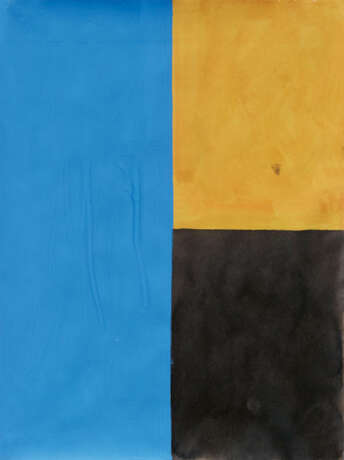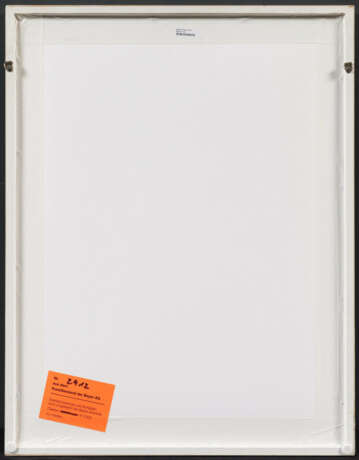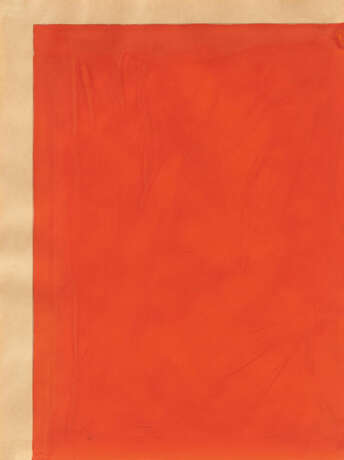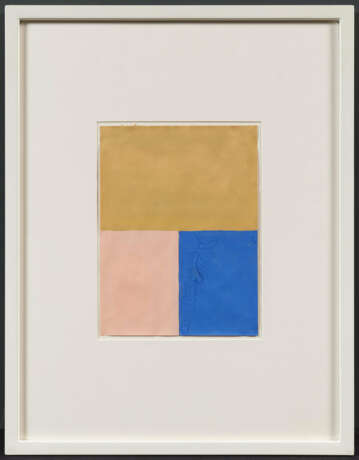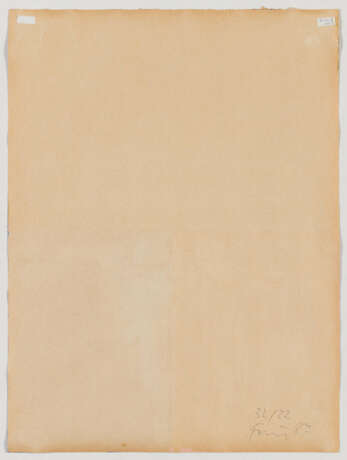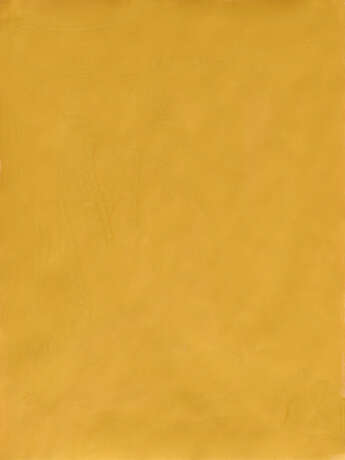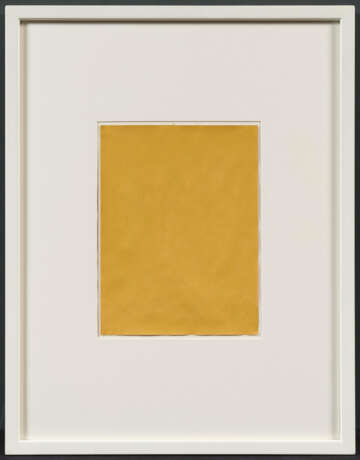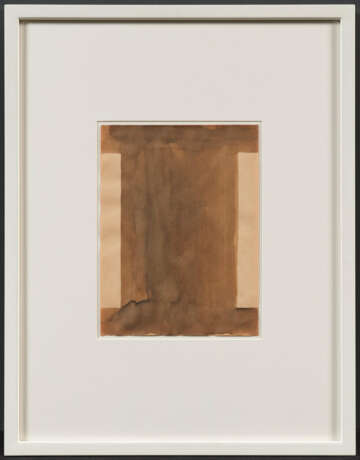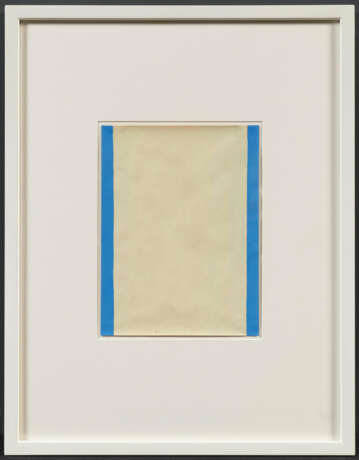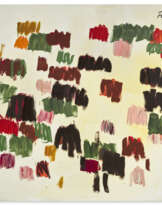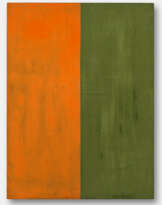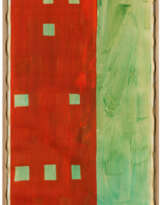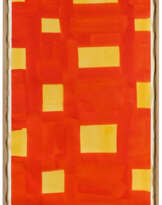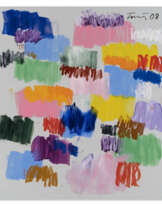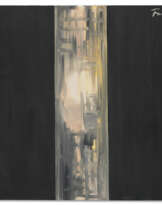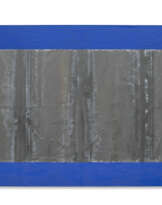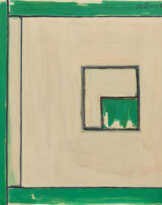ID 1405989
Lot 149 | Günther Förg. Untitled
Estimate value
€ 70 000 – 100 000
1952 Füssen - 2013 Freiburg
Title: Untitled.
Subtitle: 32 parts.
Date: 1987.
Technique: Each: Watercolour and gouache on brown paper.
Measurement: 32 x 24cm.
Notation: Signed and dated verso: Förg 87. Here also each labelled consecutively from 1/32 to 32/32.
Frame/Pedestal: Framed.
The work is registered under the number WVF.87.P.1717 in the archive of the Estate of Günther Förg. We would like to thank Mr. Michael Neff of the Estate of Günther Förg, Frankfurt a.M., for kindly confirming the authenticity of this work.
Provenance:
- Galerie nächst St. Stephan, Vienna
- Bayer Inc., USA
- Bayer AG, Leverkusen (acquired from the previous owner in 2005)
Exhibitions:
- Martin-Gropius-Bau, Berlin 2013
Literature:
- Farbenfabriken Bayer (ed.): Kunstwerk - Bildende Kunst bei Bayer, Leverkusen 1992, p. 159, fig.
- Miksche, Uta: Bayer Collection of Contemporary Art, Sewickly 1995, p. 38f., fig.
- Exhib. cat. From Beckmann to Warhol, Art of the 20th and 21st Centuries - The Bayer Collection, Martin-Gropius-Bau, Cologne 2013, p. 230, fig.
- Strong spatial presence
- Powerful composition in the artist's unmistakable visual language
- Comparable works are rarely offered on the auction market
Meister vieler Medien
Das Oeuvre Günther Förgs zeichnet sich vor allem durch Vielschichtigkeit aus. Gekonnt wechselt er zwischen Malerei, Skulpturen und Fotografien und erfindet sich ständig neu. Neben seiner konsequenten Weiterentwicklung zieht sich seine Auseinandersetzung mit Architektur und Geschichte und vor allem die Fragen zum Wesen der Kunst selbst wie ein roter Faden durch sein Schaffen. Dabei nimmt das Verhältnis von Fläche und Raum eine zentrale Rolle ein.
Schon in seinem Studium an der Akademie der Bildenden Künste in München, wo er von 1973 bis 1979 bei Carl Fred Dahmen lernt, hinterfragt er traditionelle Techniken und akademische Vorgehensweisen und beginnt in dieser Zeit mit seinen ersten Bleibildern. Günther Förgs Bildsprache entwickelt sich aus der Abstraktion, doch im Gegensatz zu seinen Vorbildern Barnett Newman und Mark Rothko, welche in ihren Werken eine in ihren Augen verlorene Einheit und Ordnung wiederherstellen zu versuchten, betont Förg: "Für mich ist die abstrakte Kunst heute das, was man sieht, und nicht mehr". (Aus einem Gespräch mit Thomas Groetz, in: Günther Förg. Bilder/Paintings 1973-1990, Galerie Max Hetzler, Berlin 2004). Im Gegensatz zum Abstraktionsbegriff der Moderne oder den "Abstract Expressionists" interessieren Förg klassische Kompositionsprinzipien wenig. Farbe und Material ordnen die Bildfläche nach ihren eigenen Gesetzmäßigkeiten. Auf ein narratives Element oder eine metaphysische Aufladung des Dargestellten verzichtet er. Der Künstler schöpft aus seinem reichen Repertoire an Inspirationen, adaptiert und transformiert Gesehenes und setzt in seinem Schaffen kontinuierlich neue Impulse in Bezug auf Material, Farbe und Raum. Seine Malerei untersteht einer ständigen Auseinandersetzung mit der Farbe, deren Eigenleben und unendliche Variationsmöglichkeiten er durch neue Kombinationen hervorhebt. Dabei gelingt es ihm, auf scheinbar mühelose Weise das Unvereinbare zu vereinen: Geometrische Strenge trifft auf expressive Spontaneität.
Harmonie ohne System?
Das hier angebotene 32-teilige Werk ist ein wunderbares Beispiel für Förgs Spiel mit Form und Farbe. Jede Arbeit besteht aus kräftigen Farbfeldern, die mal mehr, mal weniger kontrastreich durch vertikale oder horizontale Farbfelder begrenzt werden. Die Farben verdünnt Förg teilweise stark mit Wasser. Der unterschiedliche Farbauftrag gibt dem Werk Lebendigkeit: Flächige, beinahe monochrome Farbfelder treffen auf vielschichtige Oberflächen, die durch sichtbare Pinselstriche entstehen. Die geometrischen Felder, scheinen intuitiv auf den Bildträger aufgetragen zu sein, lassen kein eindeutiges System erkennen und wirken willkürlich angeordnet, dabei aber harmonisch austariert. Die einzeln betrachteten kleinformatigen Werke werden in ihrer Gesamtheit zu einer kraftvollen Komposition, welche den Betrachter unweigerlich zu freien Assoziationen einlädt.
| Artist: | Gunther Förg (1952 - 2013) |
|---|---|
| Auction house category: | Post War paintings, drawings, watercolours |
| Artist: | Gunther Förg (1952 - 2013) |
|---|---|
| Auction house category: | Post War paintings, drawings, watercolours |
| Address of auction |
VAN HAM Kunstauktionen GmbH Hitzelerstr. 2 50968 Köln Germany | ||||||||||||||
|---|---|---|---|---|---|---|---|---|---|---|---|---|---|---|---|
| Preview | |||||||||||||||
| Phone | +49 221 92586215 | ||||||||||||||
| Fax | +49 221 92 58 62 4 | ||||||||||||||
| Buyer Premium | 32% | ||||||||||||||
| Conditions of purchase | Conditions of purchase | ||||||||||||||
| Business hours | Business hours
|

